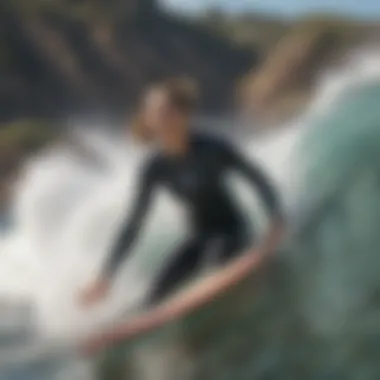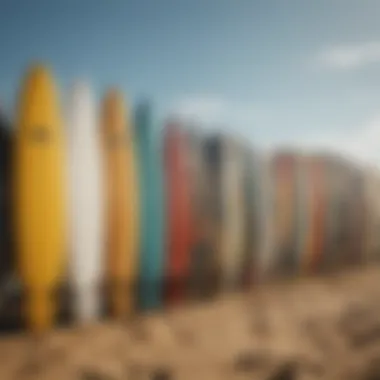Explore California Surf Camps Tailored for Adults


Intro
California’s coastline paints a picture of shimmering waves and sun-drenched beaches. For many, surf camps are not just for kids anymore. Adult surf camps have popped up from Santa Cruz to San Diego, offering a range of experiences tailored for grown-ups looking to ride the wave, immerse themselves in beach culture, and hone their surfing skills.
This transition from inexperienced to adept surfer is central to what these camps provide. New surfers seeking guidance will find patient instructors and supportive communities. Experienced surfers looking to perfect advanced techniques will discover camps that challenge their limits. Whether you are catching your first wave or trying to shred the gnar, these camps have something for everyone.
In this article, we’ll take a closer look at the variety of surfing techniques that can be learned in these camps, delve into the gear necessary for a successful surf trip, and explore the unique vibes of different locations. From the thrill of standing on your board to the camaraderie shared with fellow surf enthusiasts, the experience of adult surf camps in California is as vibrant as the surf itself.
California is often described as the heartbeat of surfing culture, pulsating with waves, sand, and the spirit of adventure. Surf camps designed for adults have sprung up across the state, catering to those who wish to embrace the thrill of riding waves while also seeking community and personal growth. These camps appeal not just to the daredevils but also to anyone interested in learning a new skill or soaking in the laid-back coastal lifestyle.
Whether you are a newbie looking to catch your first wave or a seasoned pro aiming to refine your technique, California surf camps offer a tailored experience. They provide training in a safe, supportive environment often led by experienced instructors who understand the nuances of adult learning. What’s more, surf camps foster connections between individuals from various walks of life, uniting them through a common passion for the ocean.
The benefits of attending these camps are manifold:
- Skill Development: Programs are structured to gradually build confidence and competence on the board.
- Community Engagement: Meeting like-minded individuals can lead to lasting friendships.
- Mental Well-being: The combination of physical activity and time spent in nature can have positive effects on mental health.
As adult participants immerse themselves in this vibrant surf culture, they often experience more than just surfing lessons. It's about participating in a lifestyle that champions sustainability, patience, and camaraderie. By understanding the intricacies of California's surf scene, attendees can better appreciate what these camps bring to the table.
"Surfing is not just a sport; it's a way of life, and California serves as the ultimate playground for adults looking to dive into this captivating world."
Through this article, we will explore various camps by region, delve into program structures that cater to all skill levels, and underscore the cultural significance of surfing along with its environmental implications. This comprehensive guide serves as a resource for those intending to join the ranks of adult surfers in California and looks deeper into how these camps might just be the catalyst for a lifelong passion.
Location Highlights
Exploring surf camps across California means diving into a variety of experiences that cater to adult surfers. The coastal diversity of this state provides not only different waves but also varying environments, personalities, and camp offerings. By highlighting location-specific surf camps, this section aims to guide enthusiasts in making informed choices based on factors like wave conditions, local culture, and accessibility.
Southern California Surf Camps
Southern California is often the poster child for surf culture. Here, the sun shines more often than not, and surfboards are as ubiquitous as palm trees. Each coastal city offers its own flavor, making the surf experience unique to each locale.
Santa Monica
Santa Monica, with its iconic pier and vibrant beach atmosphere, has fully embraced its surf culture. This location offers a variety of camps designed for all skill levels. The key characteristic of Santa Monica is its consistent surf conditions, which make it a popular choice for beginners.
The unique feature of the area is the urban integration of surf culture. It's a place where enthusiasts can not only learn to ride waves but also enjoy the lively boardwalk filled with shops, cafes, and entertainment. This makes the camp experience not solely focused on surfing, but also on social connections and exploring a bustling beach lifestyle. However, the crowded beach can be a disadvantage, especially for those looking for more tranquil surf sessions.
Laguna Beach
Laguna Beach stands out for its stunning cliffs and coves, which provide a picturesque backdrop for any surf camp. Here, camps often cater to a more artistic crowd, emphasizing the harmony between surfing and art. This area is known for its clear waters and varying wave sizes, making it beneficial for both learners and seasoned surfers.
The artistic influence not only beautifies the environment but also fosters a creative vibe, inviting surfers to relax and get inspired. However, being a trendy destination can mean higher costs, which may not fit every budget.
San Diego
San Diego is famed for its epic surf spots, like Mission Beach and La Jolla. The warm water and diverse wave conditions available here attract surf camps that offer tailored experiences, from deepening basic skills to advanced techniques. Besides great surf, the area boasts a laid-back surf culture, making it attractive for adults seeking both fun and relaxation.
One of the notable aspects is the community feel. Many surf camps encourage social mingling and outdoor activities beyond surfing, like beach volleyball or even yoga. However, this popularity can lead to busier beaches, which might not be ideal for everyone.
Central California Surf Camps
Central California offers a more rugged and raw surf experience when compared to the southern beaches. The natural beauty of this region, including coastal cliffs and marine life, enhances the surfing adventure.
Monterey
Monterey is perhaps less known for its surfing compared to its marine sanctuary. It offers surfers a unique blend of pristine waters and abundant wildlife. The camps here focus on teaching surfers about the ecosystem while they learn to ride the waves.
The remarkable aspect of Monterey is its educational approach to surfing and conservation, making it a beneficial choice for surfers passionate about the ocean. Yet, the cool waters can be daunting for beginners not accustomed to chilly conditions.
Big Sur
Big Sur hippies have long celebrated the rhythm of the tides, and its surf camps are no different. Known for its breathtaking views and dramatic coastlines, Big Sur’s camps often prioritize personal growth alongside surfing skills. The camps tend to focus on connecting with nature, thus offering a holistic and transformative experience.
The main downside, however, is access. Some surfing spots can require a bit of travel or hiking, which isn't ideal for everyone.
Pismo Beach
Pismo Beach prides itself on being welcoming to all, offering consistent waves and a friendly community atmosphere. It’s particularly known for its long, sandy beaches, perfect for learners. Surf camps here often have a relaxed vibe, which attracts adult surfers looking for a low-pressure environment.
The unique aspect of Pismo Beach is its diverse surfing conditions, making each experience different. However, renting equipment can get pricey, leading to hidden costs for those on a budget.
Northern California Surf Camps
Northern California is where the ocean rawness truly shines, featuring powerful surf spots that attract advanced surfers. Here, the culture holds a different tone, focusing more on strength and connection to nature.


Santa Cruz
Santa Cruz, with its iconic surf scene, is a flagship for surf culture in this region. The waves here are thrilling, making it a primary destination for skill development. Many camps focus not just on surfing but on the philosophy of the sport, which appeals to more experienced surfers seeking to deepen their engagement with the ocean.
The local vibe fosters community, and this is evident in how camps encourage group activities beyond the waves. Yet, the sometimes overcrowded surf spots might frustrate those wanting to enjoy serene sessions.
Half Moon Bay
Famous for the Maverick's surf event, Half Moon Bay is remarkable for its big wave surfing. Still, it also offers camps for those looking to test their mettle. The camps here are often tailored to those seeking a challenge and are passionate about pushing their limits.
One major characteristic is the excitement level, driving surfers to explore their potential. However, this isn’t a beginner-friendly location; its waves can be daunting for the uninitiated.
Mendocino
Mendocino brings a different flavor with beautiful landscapes and laid-back surf conditions. Unlike its neighbors, this area appeals to those wanting a quieter, more reflective surf experience. Mendocino’s camps often focus on mindfulness in the water, integrating meditation with surfing.
The unique feature here is the tranquility��—a big draw for adults looking to escape frenetic lifestyles. However, inconsistent surf conditions can challenge those wanting reliable waves.
In essence, where one decides to engage with California's surf camps can shape not only the learning experience but also the memories made. Understanding the unique aspects of each camp location helps surfers select the perfect fit for their goals.
Program Structure and Offerings
Understanding the structure and offerings of surf camps is key to truly grasping what they can provide for adults looking to immerse themselves in the surfing lifestyle. The very essence of these camps lies not just in catching waves, but in fostering an environment that promotes personal growth, skill enhancement, and community connection. Adult surf camps are crafted to cater to different levels and aspirations, accommodating anyone from the tentative novice to the seasoned rider aiming to refine their skills. This structured approach lends a sense of purpose to the experience, ensuring that everyone leaves with something valuable—be it the thrill of riding their first wave or mastering an advanced maneuver.
Types of Surf Lessons Available
Beginner Programs
Beginner programs stand out as the gateway for those new to the surfing world. Designed specifically for those who have little to no experience, these programs introduce participants to the basics of surfing. They typically cover key elements like paddling techniques, wave etiquette, and standing up on the board. The key characteristic of beginner programs is their supportive learning environment, often led by patient instructors who foster confidence among learners.
One unique feature of these programs is the use of foam boards, which are more forgiving on falls and provide a sense of security—essential for first-timers. This contributes to a more enjoyable and less intimidating experience. However, participants should be prepared for the physical demands of learning to balance on the board which can be challenging yet rewarding.
Intermediate Workshops
Moving up the ladder, intermediate workshops cater to those who already possess basic surfing skills but wish to refine their techniques. These workshops delve into more advanced topics, including turning, riding bigger waves, and understanding surf conditions. A major benefit of intermediate workshops is that they often focus on personalized feedback, with instructors assessing individual needs and tailoring the lessons accordingly.
Workshops sometimes feature equipment that is designed to challenge while still being accessible, such as shorter boards and varying fin setups, adding layers to the learning experience. One advantage here is the camaraderie built among participants, as they often share similar skill levels and face challenges together, creating a sense community.
Advanced Clinics
For those at the pinnacle of their surfing journey, advanced clinics offer specialized training meant to push limits. These clinics focus on fine-tuning advanced techniques, such as maneuvering in specific types of waves or mastering aerial tricks. A key characteristic of advanced clinics is the in-depth video analysis, allowing surfers to see their performance from a new perspective.
Participants can expect to be pushed to their limits in a supportive but challenging atmosphere, often enjoying the thrill of competing against peers in friendly challenges. While highly beneficial, these clinics are understandably demanding, and participants should come prepared both mentally and physically to maximize their experience.
Support Services and Amenities
Equipment Rental Options
A significant aspect of surf camps is their provision of equipment rental options. Many camps offer a diverse range of surfboards, wetsuits, and additional gear tailored to different skill levels and waves. This flexibility is particularly beneficial for those who may be traveling and might not want to lug their gear across the state. By providing top-notch equipment, camps enhance the safety and performance of their participants.
Customizable rental packages can include everything from standard shortboards to longboards, each serving its own purpose based on wave type. One downside, however, can be the additional costs that accompany rentals, which some might not expect. On the flip side, being able to test different types of boards can ultimately enlighten surfers about their preferences and performance aspects.
Accommodation Arrangements
The accommodation arrangements provided by surf camps can vary significantly, with options ranging from luxurious beachfront lodges to more budget-friendly shared housing. Choosing the right setup can influence the camp experience, with many opting for a social vibe that encourages interaction among participants, and others selecting secluded settings for personal reflection.
A standout feature is often the proximity to surf spots, offering convenience and accessibility. However, mixed accommodation options can lead to differences in comfort levels and social experiences. Therefore, evaluating personal preferences and travel expectations is essential when selecting a camp.
Meal Plans
Surfing isn’t just about the waves; it’s also about fueling the body properly. Meal plans at surf camps are designed to cater to the diverse nutritional needs of adults, often including options for various dietary restrictions. This consideration enhances the overall experience, encouraging a communal dining atmosphere where participants gather to share stories and tips over wholesome food.
However, it is worth noting that not all plans will be created equal; some may only provide basic meals, while others offer gourmet options. Consequently, surfing enthusiasts should research meal reviews beforehand to find a plan that aligns with their expectations and nutritional needs.
Social and Community Activities
Evenings by the Fire
Evenings by the fire represent a cherished tradition in surf camp culture. After a strenuous day of riding waves, participants gather around the fire to unwind. Storytelling, sharing tips, and enjoying camaraderie often come into play, bringing people together and allowing for connections that might not happen during the daytime surf lessons.
This activity is popular because it creates lasting bonds and offers a moment to reflect on the day’s achievements, no matter how big or small. Participants often leave these encounters with newfound friends and a sense of belonging.
Surfboard Workshops


Crafting one’s own surfboard is a unique highlight that some camps offer through surfboard workshops. These sessions give participants hands-on experience in shaping and customizing boards, leveraging creativity while providing insight into materials and construction. The enriching experience enhances participants' understanding of the craft behind surfing, often resulting in a deeper connection to their sport.
While informative, these workshops can be demanding—requiring attention to detail and a willingness to get a bit messy. Nevertheless, the joy of surfing on a board one has crafted is an unforgettable and fulfilling accomplishment.
Community Challenges
Community challenges are an excellent way for surf camps to foster a sense of teamwork and friendly competition amongst participants. These challenges often involve various contests, from paddle races to best trick competitions. A key characteristic of such events is the inclusive spirit, as they encourage all levels to join in the fun, enhancing the camaraderie among participants.
On the flip side, the pressure to perform can be overwhelming for some, and it’s crucial for camps to frame these competitions in a way that emphasizes enjoyable participation over cutthroat rivalry. However, participants often walk away from these experiences with increased motivation and a more profound connection to fellow surfers.
Choosing the Right Surf Camp
Selecting the right surf camp can make or break your experience on the waves, especially for adults who may have different priorities compared to younger surfers. A valid surf camp not only helps improve your skills but also connects you with a community of like-minded individuals. Factors such as the camp's vibe, its location, and the actual costs involved play a critical role in this decision-making process. Let’s dive into what you ought to consider in order to catch the best wave for you.
Factors to Consider
Skill Level
When it comes to surfing, knowing your skill level is like knowing how to read the wave. A beginner will look for a different kind of camp than someone who's been riding the waves for years. Beginner programs often focus on the fundamentals, making it a fun and stress-free environment. Meanwhile, intermediate and advanced workshops may dive into more complex techniques, allowing for progression.
It's crucial to honestly assess your abilities. If you overestimate your skills, you may find yourself out of your depth, and that's no fun. Televising surf camps will often specify the skill levels they cater to. For those just dipping their toes into the water, beginner groups are often a perfect fit. They provide a supportive atmosphere, and let’s face it, the stoke of learning something new can be quite inspiring.
Camp Size and Atmosphere
The size of a surf camp can significantly shape your experience. Larger camps typically offer a variety of programs and amenities but might come with a more competitive atmosphere. Low-key, smaller camps usually foster a tight-knit community vibe that some adult surfers might find appealing. It really depends on what kind of experience you are hoping for.
Moreover, the camp atmosphere is essential. Some folks want to mingle, while others might prefer a more solitary experience focused solely on skill enhancement. Imagine lounging with fellow surfers around a bonfire after a long day of riding; this camaraderie is often easier to find in smaller camps as opposed to a bustling, larger one. You want to choose what feels right and will help you unwind after a day on the waves.
Location Preferences
Californian coastlines are as diverse as its surf camps. Location preferences are bound to affect your decision significantly. Are you looking for the iconic beach breaks of Santa Monica or the pristine shores of Laguna Beach?
Each area has its unique flavor and type of waves. Some locations cater more to beginners, while others are better suited for intermediate and advanced surfers. Beyond the surf, the local culture, accessibility, and even climate can shape the overall experience. For instance, if you are more drawn to a laid-back beach town vibe, you might want to avoid the hustle and bustle of a metropolitan area.
Cost Analysis of Surf Camps
Tuition Fees
Understanding tuition fees is fundamental. Costs for surf camps can vary based on several factors including the duration, location, and prestige of the camp. On the surface, fees may seem steep, but these often cover not only the lessons but also facilities and possibly accommodation.
When considering tuition fees, take a moment to ponder what you truly get for your investment. A more expensive camp might offer specialized instructors or unique experiences you wouldn’t find elsewhere, while budget-friendly options still may provide quality surfing lessons without the frills.
Hidden Costs
Dig a little deeper regarding hidden costs. It’s essential to read the fine print. Some camps advertise very competitively, but charges for equipment rentals, meals, or even excursions can skyrocket your budget in a jiffy.
A savvy surfer should inquire about all potential expenses upfront. Some placements throw in group meals as part of the package, while others don't. Being informed contributes to a smoother experience once you're on your surfboard, without the worry of unexpected bills.
Value Comparisons
Doing a value comparison on surf camps requires some methodical evaluation. Look at what’s included in the price. For instance, does a camp that costs a bit more offer added value, like personalized coaching or more flexible schedules?
Comparing different packages helps in discerning which camps provide truly good bang for your buck. Make sure to weigh most options carefully; sometimes a slightly more expensive camp might be a much better deal in the end.
Seeking Reviews and Testimonials
Online Platforms
One of the best ways to gauge a surf camp's worth is through online platforms. Websites like TripAdvisor and Reddit host vital insights from past campers, offering real-world accounts. It can be enlightening to see what people truly think about their experiences.
Check out the recurring themes in the reviews. A camp might flaunt great facilities but falter in the quality of instructors. Firsthand experiences can paint a clearer picture that brochures often gloss over.
Personal Recommendations
Word of mouth is another valuable resource. Friends or acquaintances who've been to surf camps in California can provide trustworthy advice. Their personal anecdotes often highlight aspects that guides or advertisements might miss.
Moreover, talking to fellow surfers at your local beach can help you tap into their intake on camps—they may have hidden gems to share that don’t necessarily make it to the mainstream sites.
Social Media Insights
Social media platforms can be a treasure trove of insights as well. Many camps showcase their offerings, activities, and happy campers on sites like Facebook or Instagram. The photos can give you a feel of the vibe, while comments and shares can help gauge overall satisfaction.
Moreover, keep your eye out for community groups or pages centered around surfing; they're a perfect space for asking questions and seeking advice.


Ultimately, choosing the right surf camp goes beyond just picking a name out of a hat. Taking the time to properly assess your options ensures a fulfilling experience in the water. 🌊
Cultural Significance of Surfing
Surfing in California is more than just a sport; it embodies a rich tapestry of culture, history, and lifestyle that has captivated people for generations. The significance of surfing in this sunny state stretches far beyond the waves. It encapsulates a way of life infused with values of community, environmental awareness, and self-expression. Throughout this section, we will explore how this exhilarating activity has influenced various aspects of culture—from its historical roots to its lasting impacts on fashion, music, and art.
Historical Context
Surfing has deep ties to California's history. The sport found its way to the mainland when Hawaiian culture made its influence felt on the U.S. coastline during the early 20th century. While surfing had its roots in Polynesian culture long before this, California surfers took the traditions and made them their own.
The 1960s marked a pivotal time in surfing, propelled into mainstream consciousness through films and music. The Beach Boys and surf films like "Endless Summer" garnered national attention, painting a picture of sun-soaked beaches and carefree living that sparked a cultural movement. Surfing began to change from a niche pastime into a symbol of youthful rebellion and freedom—a representation of the California dream.
Today, it continues to evolve, reflecting broader societal changes while remaining embedded in California's coastal identity.
Surfing as a Lifestyle
Influence on Fashion
Surfing's influence on fashion is unmistakable, shaping trends that reach far beyond the beach. When one thinks of surf fashion, images often come to mind—colorful board shorts, vintage tees, and casual flip-flops. These aren’t just clothes; they reflect an attitude and a lifestyle.
Style elements from surf culture embrace comfort and functionality, making them appealing choices not just for surfers but for the general populace. Surfer brands like Quiksilver and Billabong don't just market clothing; they curate a lifestyle. This casual, laid-back aesthetic has become woven into the everyday wardrobe of countless individuals, promoting a sense of freedom and adventure.
However, it's worth noting the potential pitfalls of commercialism. Some argue this dilution of surf style into mainstream fashion may detract from its authenticity, potentially leading to an erosion of the grassroots culture from which it sprang.
Impact on Music
The connection between surfing and music has produced an enriching cultural interplay. Genres from rock to reggae have been woven into the surfing narrative, creating a soundtrack that resonates with both the waves and the lifestyles they inspire. Surfers often turn to music to enhance their experiences—whether it's the twang of makeshift beach parties or the vibrant jams in a local surf shop.
The band The Beach Boys, for instance, transformed surf culture into an anthem that remains iconic. Their catchy tunes brought the joy of riding waves into the hearts of many, forging connections between surfing, youth, and an optimistic outlook on life. Music festivals often celebrate surfing, where waves and beats create a harmonious experience cherished by many.
But along with this fusion comes the risk of commercialization overshadowing genuine creativity, which can disengage authentic voices from the surfing community.
Artistic Expressions
Surfing has served as a muse for various artistic mediums including painting, photography, and sculpture. The ocean and the act of riding waves become subjects of beautiful artworks emulating fluidity and dynamism. Local artists often capture their love for the surf culture, creating pieces that resonate with both surfers and the broader community.
Furthermore, surfboard design itself has evolved into an art form, merging aesthetics with performance. Artists often collaborate with board shapers to craft visually stunning boards that tell a story, displaying local culture and environmental awareness.
Each brush stroke and curve can reflect the individuality of the surfer while also addressing issues such as sustainability in materials and practices.
While artistic interpretations continue to flourish, some worry that the commodification of art in surf culture dilutes its message, risking the loss of its profound significance.
"Surfing is like music. The sounds of the waves are a rhythm, while the colors of the ocean express creativity far beyond what words can capture."
Environmental Considerations
When it comes to surf camps in California, one cannot overlook the crucial role that environmental considerations play. Surfing is more than just a sport; it’s a lifestyle deeply intertwined with nature. Thus, understanding how surf camps impact the environment—and how they strive to minimize this impact—is essential for every surf enthusiast.
Sustainability Practices in Surf Camps
Sustainable practices within surf camps are increasingly becoming the norm rather than the exception. Many camps are adopting eco-friendly methods that emphasize the conservation of natural resources and the well-being of local ecosystems. These practices often include:
- Eco-Friendly Materials: From surfboards to the very tents where campers sleep, using sustainable materials is key. Bamboo surfboards and organic cotton sheets are just a couple of examples.
- Waste Reduction Initiatives: Camps actively promote recycling programs and have reduced single-use plastics, encouraging participants to bring reusable water bottles and containers. In some cases, you might even find composting facilities!
- Local Sourcing: Many surf camps make a conscious effort to source food and supplies locally. This not only cuts down on transportation emissions but also supports the local economy.
Such practices not only contribute towards a healthier planet but also instill in surf campers an appreciation for nature and environmental stewardship.
Marine Conservation Efforts
Given that surfing takes place in the ocean, marine conservation is a pressing concern for surf camps. Many of these camps participate in or support local conservation efforts aimed at protecting marine biodiversity. Engaging in activities like beach cleanups helps foster a sense of responsibility towards the ocean. These efforts may include:
- Beach Clean-Up Campaigns: Many camps organize days dedicated to cleaning up local beaches, removing trash and debris that could harm marine wildlife.
- Partnerships with Conservation Organizations: Collaborations with groups like Surfrider Foundation allow camps to amplify their conservation impact. They may host workshops educating surfers about ocean health and marine ecosystems.
- Education on Local Wildlife: Many camps focus on teaching participants about local marine species and their habitats. Understanding the delicate balance of coastal ecosystems encourages surfers to respect and protect these environments.
"Surfing is a way to connect with nature, and protecting that nature should be part of every surfer's journey."
Culmination
The discussion surrounding surf camps for adults in California culminates in a realization of their profound significance, not only in terms of skill development but also in fostering community and promoting a lifestyle centered around surfing. These camps are more than just a place to learn to ride waves; they provide unique opportunities that can shape an individual's surfing journey and, in many cases, their overall life perspective.
The Lasting Impact of Surf Camps
Surf camps leave a mark that transcends the mere act of surfing. Many participants emerge from these structured environments with not just improved skills, but also a deepened connection to both the ocean and fellow surf enthusiasts. For instance, someone who begins with little knowledge about the ocean might leave a camp capable of tackling more challenging waves, but even more importantly, they gain camaraderie with their peers. This bond, often fostered during group sessions and evening bonfires, creates a support system that lingers well beyond the camp's duration.
Furthermore, surf camps instill environmental awareness. Given California’s stunning coastal environment, participants are often educated on marine conservation efforts and sustainability practices integrated into their training. A common narrative among camp-goers is the appreciation for the ocean’s beauty, driving many to become advocates for its preservation. A camp participant might find themselves motivated to join beach clean-ups or speak up about ecological concerns, thus cultivating a lifelong commitment to environmental stewardship.
Encouraging a Lifelong Passion for Surfing
The beauty of adult surf camps lies in how they ignite a lifelong passion for surfing. The programs are crafted not just to instruct but to inspire. When adults engage in surfing alongside like-minded individuals, they often discover a passion that they may have never explored before.
Engaging lessons, coupled with the thrill of catching one's first wave, lays the groundwork for an enduring love of the sport. Beyond technical skills, these camps emphasize resilience, patience, and joy – vital traits that resonate in all aspects of life. It’s common for participants to leave the camp eager to continue their surfing journey, whether through finding local spots back home or planning future surf trips.
In addition, many surf camps foster a sense of community that often turns into a lifelong network. Participants frequently connect on social media platforms like Facebook or Reddit to share their surfing experiences and organize meet-ups. This facilitates an ongoing connection to the sport, enabling individuals to continuously push their limits and enjoy surfing beyond the confines of camp.















